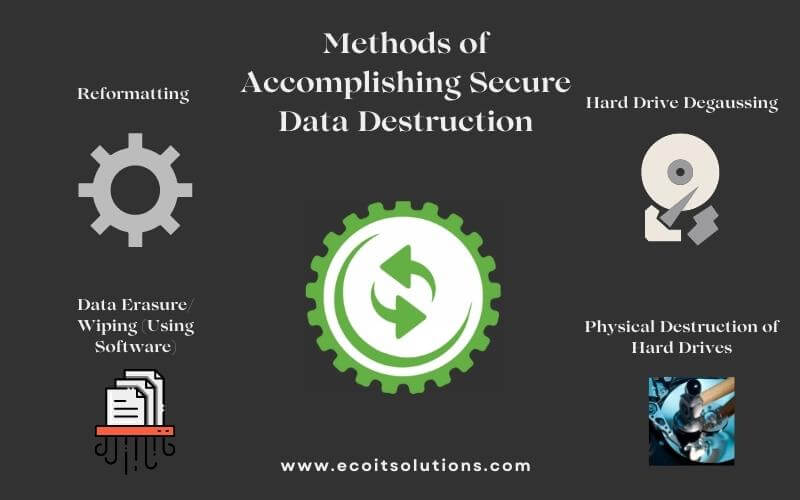The Effect of Effective Data Destruction on Cyber Security Risk Monitoring
The Effect of Effective Data Destruction on Cyber Security Risk Monitoring
Blog Article
The Relevance of Effective Information Damage Practices in Shielding Sensitive Info and Ensuring Computer Protection
In an era where data violations are increasingly common, the value of effective information devastation practices can not be overstated. Organizations face significant risks when sensitive details is improperly dealt with, possibly bring about unauthorized access and extreme economic repercussions. Applying durable data devastation methods not just mitigates these threats yet likewise aligns with lawful compliance demands, ensuring that organizations promote their credibility and foster customer trust. Nevertheless, the concern stays: what certain techniques can be used to enhance these techniques, and just how can organizations properly integrate them into their overall cybersecurity structure?
Understanding Data Devastation
Understanding information damage is vital in today's electronic landscape, where sensitive info can conveniently be jeopardized. Reliable data destruction entails not just making sure but removing data that information is irretrievable with comprehensive approaches. This process is essential for organizations that take care of confidential client details, intellectual building, or internal papers, as any kind of breach can bring about severe economic and reputational consequences.
Data destruction incorporates various strategies, consisting of shredding physical media, degaussing magnetic storage space devices, and using software-based solutions that overwrite information several times. Each method offers a specific function and needs to straighten with the sensitivity of the information being thrown away. For instance, physical damage is commonly favored for hard disks including highly private information, while software methods may be enough for much less delicate details.
In addition, sticking to sector standards and laws, such as the General Data Protection Policy (GDPR) or the Medical Insurance Portability and Responsibility Act (HIPAA), is vital for compliance and to mitigate lawful threats. Organizations should create a robust information destruction plan, train workers on finest methods, and consistently examine their procedures to make sure that all sensitive info is taken care of securely and properly.
Threats of Inadequate Practices
Inadequate information devastation practices subject companies to substantial threats that can have far-reaching effects. When sensitive information is not properly disposed of, it continues to be prone to unapproved gain access to, which can lead to data violations and identity theft. Such cases not just endanger the protection of people but likewise stain the organization's online reputation, leading to a loss of consumer trust and possible financial consequences.
In addition, regulative conformity is increasingly rigid in numerous sectors. Failure to follow data destruction guidelines can result in hefty penalties and lawsuits against companies. These fines can stress funds and divert interest from core company operations.
On top of that, the abuse of residual data can cause copyright theft or business reconnaissance, threatening competitive benefits (data destruction). The impact of insufficient data devastation extends past immediate monetary losses; it can additionally result in long-lasting damages to brand name integrity and market setting

Organizations must acknowledge that information safety and security is not only regarding protecting against violations; it additionally encompasses the liable monitoring of information throughout its lifecycle. Neglecting effective data destruction procedures can have disastrous effects, highlighting the requirement for durable actions to mitigate these risks.
Best Practices for Data Damage
Applying effective data destruction techniques is crucial for protecting sensitive details and maintaining compliance with regulatory standards. Organizations must take on a multi-faceted approach to ensure that information is irretrievable, thereby avoiding unauthorized gain access to and possible violations.
First, information need to be categorized based on level of sensitivity, permitting organizations to apply appropriate destruction approaches customized to the degree of danger. For electronic information, utilizing software-based data-wiping devices that follow market standards can effectively overwrite existing information. Physical destruction approaches, such as shredding or degaussing, are crucial for devices that keep sensitive info, ensuring total removal.
Developing a clear information retention policy is essential, describing exactly how long various kinds of details ought to be retained prior to devastation. Routine audits of information storage systems are likewise needed to recognize obsolete or unnecessary data requiring elimination.
Moreover, training staff members on the importance of information destruction and the specific protocols to follow fosters a culture of safety and security within the company. Lastly, preserving paperwork of information destruction refines provides accountability and supports compliance with external regulations and internal plans. By sticking to these ideal techniques, organizations can considerably minimize the dangers connected with data exposure.
Legal and Conformity Factors To Consider

Failing to adhere to these policies can result in extreme penalties, including significant penalties and reputational damages. Organizations has to execute a robust information destruction policy that aligns with these legal structures and supplies clear guidelines on the proper techniques of data disposal, whether physical shredding or digital wiping.
In addition, keeping documentation of data destruction activities is vital for demonstrating compliance during audits or assessments. By focusing on legal and compliance considerations, organizations can enhance their information safety and security posture and foster trust with stakeholders and customers, ultimately contributing to an extra safe information monitoring atmosphere.
Advantages of Effective Information Damage
Efficient data destruction techniques expand past simple conformity; they offer significant Full Report benefits to companies that prioritize them. By making certain that delicate information is irretrievably damaged, organizations reduce the threat of information violations and the potential monetary consequences linked with them. This proactive approach not only safeguards versus unapproved accessibility however also boosts the overall trustworthiness of the company in the eyes of stakeholders and customers.
Carrying out robust data damage approaches, such as physical damage of storage devices or advanced data wiping strategies, adds to the fortifying of a company's cybersecurity posture. data destruction. It reduces the possibility of copyright burglary and protects exclusive details, thereby maintaining an affordable edge on the market

Final Thought
In final thought, effective data damage practices are crucial for securing delicate information and boosting general computer security. Inevitably, a commitment to robust data devastation strategies fosters a culture of obligation, thus enhancing an organization's cybersecurity posture and keeping customer trust fund.

Report this page